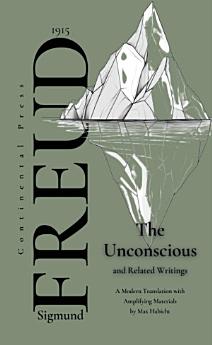The Unconscious: and Related Writings of Freud
May 2024 · The Collected Complete Works of Sigmund Freud Book 21 · Continental Press
Ebook
124
Pages
family_home
Eligible
info
reportRatings and reviews aren’t verified Learn More
About this ebook
A modern rendering of Sigmund Freud’s seminal 1915 essay The Unconscious (Das Unbewußte), along with related works that explore the nature, function, and manifestations of the unconscious mind. This edition unifies Freud’s core writings on the unconscious, including Instincts and Their Vicissitudes (1915), Mourning and Melancholia (1917), and The Uncanny (1919). Together, these works provide a comprehensive exploration of the unconscious as the driving force behind human behavior, emotions, and creativity. In The Unconscious, Freud elaborates on his theory of the dynamic unconscious, describing how repressed thoughts, desires, and memories influence conscious behavior and mental processes. He introduces the concept of the unconscious as a reservoir of psychic energy, governed by its own laws and logic, which often conflict with the demands of reality and morality. This essay lays the foundation for Freud’s structural model of the psyche, which he would later develop in works such as The Ego and the Id (1923). Instincts and Their Vicissitudes examines the transformation of primal instincts, such as sexuality and aggression, into complex psychological phenomena. Freud argues that instincts are not fixed but undergo various vicissitudes, including repression, sublimation, and reversal, shaping individual personality and behavior. Mourning and Melancholia explores the psychological mechanisms of grief and depression, distinguishing between normal mourning, which involves a gradual withdrawal of emotional attachment to a lost object, and melancholia, a pathological form of grief characterized by self-reproach and a loss of self-esteem. Freud’s analysis of melancholia as a form of internalized aggression remains a cornerstone of psychoanalytic theory. The Uncanny delves into the eerie sensation of encountering the familiar in unfamiliar contexts, such as déjà vu, doppelgängers, and supernatural experiences. Freud argues that the uncanny arises when repressed childhood fears and desires resurface in adulthood, blurring the boundary between reality and fantasy. This fresh, modern translation from the original German manuscript breathes new life into these historically significant works. Freud’s extensive writings have often been inaccessible to the general reader, and this edition seeks to bridge that gap by providing direct access to his original ideas. The Reader’s Edition introduces Freud’s work in context, with an illuminating Afterword that explains his philosophical project, situates it within the Modernist milieu, and explores its enduring impact on contemporary thought. The Afterword also examines the relationship and intellectual conflict between Freud and Carl Jung, particularly their differing views on the nature of the unconscious. While Freud emphasized the role of repressed desires and childhood experiences, Jung focused on the collective unconscious and archetypal symbols. Accompanied by a timeline of Freud’s life and works, an index of philosophical terminology, and a short biography, this edition is an indispensable resource for students, scholars, and anyone interested in the origins of psychoanalysis. The inclusion of supplemental materials, such as illustrations and a glossary of Freudian psychological terms, enhances the reader’s understanding of this complex and historically important work.
About the author
Sigmund Freud (1856-1939) was an Austrian neurologist and the founder of psychoanalysis, a groundbreaking approach to understanding the human psyche. Freud introduced concepts such as the unconscious mind, repression, and the tripartite structure of the psyche, which includes the id, ego, and superego. His work, including seminal texts like The Interpretation of Dreams and Beyond the Pleasure Principle, emphasized the role of unconscious drives and childhood experiences in shaping behavior and personality. Freuds theories on sexuality, defense mechanisms, and dream analysis challenged societal norms and profoundly altered the field of psychology, influencing literature, art, and philosophy. Though controversial, his contributions laid the foundation for modern psychotherapy and continue to spark debates and inspire new approaches to understanding human behavior and mental processes.
Rate this ebook
Tell us what you think.
Reading information
Smartphones and tablets
Install the Google Play Books app for Android and iPad/iPhone. It syncs automatically with your account and allows you to read online or offline wherever you are.
Laptops and computers
You can listen to audiobooks purchased on Google Play using your computer's web browser.
eReaders and other devices
To read on e-ink devices like Kobo eReaders, you'll need to download a file and transfer it to your device. Follow the detailed Help Center instructions to transfer the files to supported eReaders.











